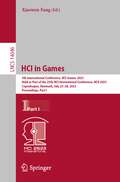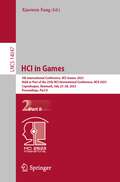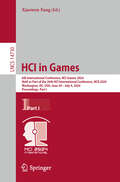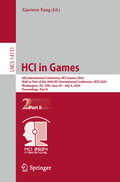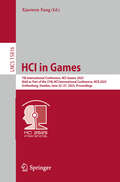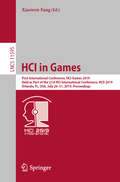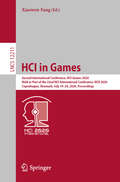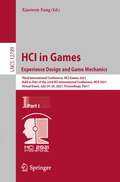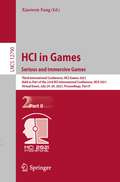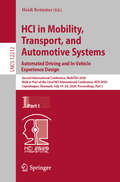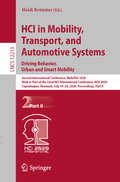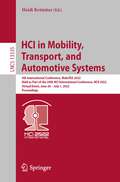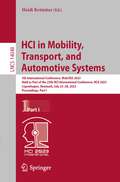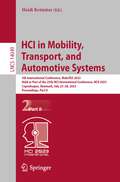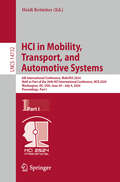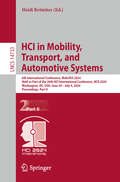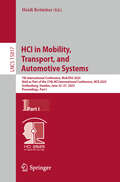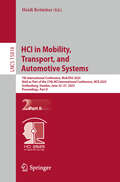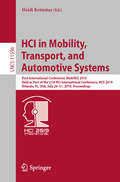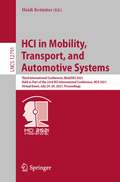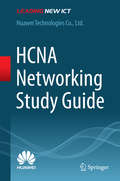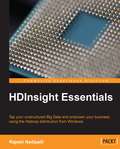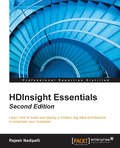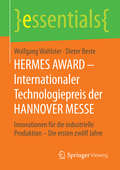- Table View
- List View
HCI in Games: 5th International Conference, HCI-Games 2023, Held as Part of the 25th HCI International Conference, HCII 2023, Copenhagen, Denmark, July 23–28, 2023, Proceedings Part I (Lecture Notes in Computer Science #14046)
by Xiaowen FangThis two-volume set of HCI-Games 2023, constitutes the refereed proceedings of the 5th International Conference on HCI in Games, held as Part of the 24th International Conference, HCI International 2023, which took place in July 2023 in Copenhagen, Denmark.The total of 1578 papers and 396 posters included in the HCII 2023 proceedings volumes was carefully reviewed and selected from 7472 submissions. The HCI in Games 2023 proceedings intends to help, promote and encourage research in this field by providing a forum for interaction and exchanges among researchers, academics, and practitioners in the fields of HCI and games. The Conference addresses HCI principles, methods and tools for better games.
HCI in Games: 5th International Conference, HCI-Games 2023, Held as Part of the 25th HCI International Conference, HCII 2023, Copenhagen, Denmark, July 23–28, 2023, Proceedings, Part II (Lecture Notes in Computer Science #14047)
by Xiaowen FangThis two-volume set of HCI-Games 2023, constitutes the refereed proceedings of the 5th International Conference on HCI in Games, held as Part of the 24th International Conference, HCI International 2023, which took place in July 2023 in Copenhagen, Denmark.The total of 1578 papers and 396 posters included in the HCII 2023 proceedings volumes was carefully reviewed and selected from 7472 submissions. The HCI in Games 2023 proceedings intends to help, promote and encourage research in this field by providing a forum for interaction and exchanges among researchers, academics, and practitioners in the fields of HCI and games. The Conference addresses HCI principles, methods and tools for better games.
HCI in Games: 6th International Conference, HCI-Games 2024, Held as Part of the 26th HCI International Conference, HCII 2024, Washington, DC, USA, June 29–July 4, 2024, Proceedings, Part I (Lecture Notes in Computer Science #14730)
by Xiaowen FangThis book constitutes the refereed proceedings of the 6th International Conference on HCI in Games, held as part of the 26th International Conference, HCI International 2024, which took place in Washington DC, USA, during June 29 - July 4, 2024. The total of 1271 papers and 309 posters included in the HCII 2024 proceedings was carefully reviewed and selected from 5108 submissions. The two volume set of HCI-Games 2024 proceedings were organized in the following topical sections: Volume 14730: Part I: Game Design and Gamification; Part II: Game-based Learning; Part III: Games and Artificial Intelligence Volume 14731: Part I: Advancing Education Through Serious Games; Part II: Player Experience and Engagement
HCI in Games: 6th International Conference, HCI-Games 2024, Held as Part of the 26th HCI International Conference, HCII 2024, Washington, DC, USA, June 29–July 4, 2024, Proceedings, Part II (Lecture Notes in Computer Science #14731)
by Xiaowen FangThis book constitutes the refereed proceedings of the 6th International Conference on HCI in Games, held as part of the 26th International Conference, HCI International 2024, which took place in Washington DC, USA, during June 29 - July 4, 2024. The total of 1271 papers and 309 posters included in the HCII 2024 proceedings was carefully reviewed and selected from 5108 submissions. The two volume set of HCI-Games 2024 proceedings were organized in the following topical sections: Volume 14730: Part I: Game Design and Gamification; Part II: Game-based Learning; Part III: Games and Artificial Intelligence. Volume 14731: Part I: Advancing Education Through Serious Games; Part II: Player Experience and Engagement.
HCI in Games: 7th International Conference, HCI-Games 2025, Held as Part of the 27th HCI International Conference, HCII 2025, Gothenburg, Sweden, June 22–27, 2025, Proceedings (Lecture Notes in Computer Science #15816)
by Xiaowen FangThis book constitutes the refereed proceedings of the 7th International Conference on HCI in Games, held as part of the 27th International Conference, HCI International 2025, which took place in Gothenburg, Sweden, during June 22–27, 2025. The total of 1430 papers and 355 posters included in the HCII 2025 proceedings was carefully reviewed and selected from thousands of submissions. The HCI-Games 2025 proceedings was organized in the following topical sections: Part 1: Gamification, UX, and Player BehaviorPart 2: Identity, Emotion, and AI in Game ExperiencesPart 3: Gamified Learning and DesignPart 4: Games in Healthcare and Wellbeing
HCI in Games: First International Conference, HCI-Games 2019, Held as Part of the 21st HCI International Conference, HCII 2019, Orlando, FL, USA, July 26–31, 2019, Proceedings (Lecture Notes in Computer Science #11595)
by Xiaowen FangThis book constitutes the refereed proceedings of the First International Conference on HCI in Games, HCI-Games 2019, held in July 2019 as part of HCI International 2019 in Orlando, FL, USA. HCII 2019 received a total of 5029 submissions, of which 1275 papers and 209 posters were accepted for publication after a careful reviewing process. The 34 papers presented in this volume are organized in topical sections named: Game Design; Gaming Experience; Serious Games; and Gamification.
HCI in Games: Second International Conference, HCI-Games 2020, Held as Part of the 22nd HCI International Conference, HCII 2020, Copenhagen, Denmark, July 19–24, 2020, Proceedings (Lecture Notes in Computer Science #12211)
by Xiaowen FangThis book constitutes the refereed proceedings of the Second International Conference on HCI in Games, HCI-Games 2020, held in July 2020 as part of HCI International 2020 in Copenhagen, Denmark.* HCII 2020 received a total of 6326 submissions, of which 1439 papers and 238 posters were accepted for publication after a careful reviewing process. The 38 papers presented in this volume are organized in topical sections named: designing games and gamified interactions; user engagement and game impact; and serious games. *The conference was held virtually due to the COVID-19 pandemic.
HCI in Games: Third International Conference, HCI-Games 2021, Held as Part of the 23rd HCI International Conference, HCII 2021, Virtual Event, July 24–29, 2021, Proceedings, Part I (Lecture Notes in Computer Science #12789)
by Xiaowen FangThis two-volume set LNCS 12789 and 12790 constitutes the refereed proceedings of the Third International Conference on HCI in Games, HCI-Games 2021, held as part of the 23rd International Conference, HCI International 2021, which took place in July 2021. Due to COVID-19 pandemic the conference was held virtually.The total of 1276 papers and 241 poster papers included in the 39 HCII 2021 proceedings volumes was carefully reviewed and selected from 5222 submissions. The regular papers of DAPI 2021, Distributed, Ambient and Pervasive Interactions, are organized in topical sections named: Experience Design in Games; User Engagement and Game Impact; Game Mechanics.
HCI in Games: Third International Conference, HCI-Games 2021, Held as Part of the 23rd HCI International Conference, HCII 2021, Virtual Event, July 24–29, 2021, Proceedings, Part II (Lecture Notes in Computer Science #12790)
by Xiaowen FangThis two-volume set LNCS 12789 and 12790 constitutes the refereed proceedings of the Third International Conference on HCI in Games, HCI-Games 2021, held as part of the 23rd International Conference, HCI International 2021, which took place in July 2021. Due to COVID-19 pandemic the conference was held virtually. The total of 1276 papers and 241 poster papers included in the 39 HCII 2021 proceedings volumes was carefully reviewed and selected from 5222 submissions. The regular papers of DAPI 2021, Distributed, Ambient and Pervasive Interactions, are organized in topical sections named: Experience Design in Games; User Engagement and Game Impact; Game Mechanics. The regular papers of DAPI 2021, Distributed, Ambient and Pervasive Interactions, are organized in topical sections named: Serious Games; Gamification and Learning; Mixed and Virtual Reality Games.
HCI in Mobility, Transport, and Automotive Systems. Automated Driving and In-Vehicle Experience Design: Second International Conference, MobiTAS 2020, Held as Part of the 22nd HCI International Conference, HCII 2020, Copenhagen, Denmark, July 19–24, 2020, Proceedings, Part I (Lecture Notes in Computer Science #12212)
by Heidi KrömkerThis two-volume set LNCS 12212 and 12213 constitutes the refereed proceedings of the Second International Conference on HCI in Mobility, Transport, and Automotive Systems, MobiTAS 2020, held as part of the 22nd International Conference on Human-Computer Interaction, HCII 2020, in Copenhagen, Denmark, in July, 2020.* A total of 1439 full papers and 238 posters have been carefully reviewed and accepted for publication in HCII 2020. The papers cover the entire field of human-computer interaction, addressing major advances in knowledge and effective use of computers in a variety of application areas. MobiTAS 2020 includes a total of 59 papers and they are organized in the following topical sections: Part I, Automated Driving and In-Vehicle Experience Design: UX topics in automated driving, and designing in-vehicle experiences.Part II, Driving Behavior, Urban and Smart Mobility: studies on driving behavior, and urban and smart mobility. *The conference was held virtually due to the COVID-19 pandemic.
HCI in Mobility, Transport, and Automotive Systems. Driving Behavior, Urban and Smart Mobility: Second International Conference, MobiTAS 2020, Held as Part of the 22nd HCI International Conference, HCII 2020, Copenhagen, Denmark, July 19–24, 2020, Proceedings, Part II (Lecture Notes in Computer Science #12213)
by Heidi KrömkerThis two-volume set LNCS 12212 and 12213 constitutes the refereed proceedings of the Second International Conference on HCI in Mobility, Transport, and Automotive Systems, MobiTAS 2020, held as part of the 22nd International Conference on Human-Computer Interaction, HCII 2020, in Copenhagen, Denmark, in July, 2020.* A total of 1439 full papers and 238 posters have been carefully reviewed and accepted for publication in HCII 2020. The papers cover the entire field of human-computer interaction, addressing major advances in knowledge and effective use of computers in a variety of application areas. MobiTAS 2020 includes a total of 59 papers and they are organized in the following topical sections: Part I, Automated Driving and In-Vehicle Experience Design: UX topics in automated driving, and designing in-vehicle experiences.Part II, Driving Behavior, Urban and Smart Mobility: studies on driving behavior, and urban and smart mobility. *The conference was held virtually due to the COVID-19 pandemic.
HCI in Mobility, Transport, and Automotive Systems: 4th International Conference, MobiTAS 2022, Held as Part of the 24th HCI International Conference, HCII 2022, Virtual Event, June 26 – July 1, 2022, Proceedings (Lecture Notes in Computer Science #13335)
by Heidi KrömkerThis book constitutes the refereed proceedings of the 4th International Conference on HCI in Mobility, Transport, and Automotive Systems, MobiTAS 2022, held as part of the 23rd International Conference, HCI International 2022, which was held virtually in June/July 2022. The total of 1271 papers and 275 posters included in the HCII 2022 proceedings was carefully reviewed and selected from 5487 submissions. The MobiTAS 2022 proceedings were organized in the following topical sections: Designing Interactions in the Mobility, Transport, and Automotive Context; Human-Centered Design of Automotive Systems; Driver Information and Assistance Systems; Studies on Automated Driving; and Micro-mobility and Urban Mobility.
HCI in Mobility, Transport, and Automotive Systems: 5th International Conference, MobiTAS 2023, Held as Part of the 25th HCI International Conference, HCII 2023, Copenhagen, Denmark, July 23–28, 2023, Proceedings, Part I (Lecture Notes in Computer Science #14048)
by Heidi KrömkerThis book constitutes the refereed proceedings of the 5th International Conference on HCI in Mobility, Transport, and Automotive Systems, MobiTAS 2023, held as part of the 25th International Conference, HCI International 2023, held in Copenhagen, Denmark, in July 2023. The total of 1578 papers and 396 posters included in the HCII 2022 proceedings was carefully reviewed and selected from 7472 submissions. The MobiTAS 2023 proceedings were organized in the following topical sections: Part I: Autonomous and Assisted Driving; Cooperative and Intelligent Transport Systems; Urban Mobility; and Sustainable Mobility. Part II: Driver Behavior and Performance; Designing Driver and Passenger User Experience; and Accessibility and Inclusive Mobility.
HCI in Mobility, Transport, and Automotive Systems: 5th International Conference, MobiTAS 2023, Held as Part of the 25th HCI International Conference, HCII 2023, Copenhagen, Denmark, July 23–28, 2023, Proceedings, Part II (Lecture Notes in Computer Science #14049)
by Heidi KrömkerThis book constitutes the refereed proceedings of the 5th International Conference on HCI in Mobility, Transport, and Automotive Systems, MobiTAS 2023, held as part of the 25th International Conference, HCI International 2023, held in Copenhagen, Denmark, in July 2023. The total of 1578 papers and 396 posters included in the HCII 2022 proceedings was carefully reviewed and selected from 7472 submissions. The MobiTAS 2023 proceedings were organized in the following topical sections: Part I: Autonomous and Assisted Driving; Cooperative and Intelligent Transport Systems; Urban Mobility; and Sustainable Mobility. Part II: Driver Behavior and Performance; Designing Driver and Passenger User Experience; and Accessibility and Inclusive Mobility.
HCI in Mobility, Transport, and Automotive Systems: 6th International Conference, MobiTAS 2024, Held as Part of the 26th HCI International Conference, HCII 2024, Washington, DC, USA, June 29–July 4, 2024, Proceedings, Part I (Lecture Notes in Computer Science #14732)
by Heidi KrömkerThis book constitutes the refereed proceedings of the 6th International Conference on HCI in Mobility, Transport, and Automotive Systems, MobiTAS 2024, held as part of the 26th HCI International Conference, HCII 2024, which took place in Washington, DC, USA, during June 29-July 4, 2024. The total of 1271 papers and 309 posters included in the HCII 2024 proceedings was carefully reviewed and selected from 5108 submissions. The MobiTAS 2024 proceedings were organized in the following topical sections: Part I: Driver behavior and safety; human factors in automated vehicles; Part II: Urban mobility and public transportation; user experience and inclusivity in MobiTAS.
HCI in Mobility, Transport, and Automotive Systems: 6th International Conference, MobiTAS 2024, Held as Part of the 26th HCI International Conference, HCII 2024, Washington, DC, USA, June 29–July 4, 2024, Proceedings, Part II (Lecture Notes in Computer Science #14733)
by Heidi KrömkerThis book constitutes the refereed proceedings of the 6th International Conference on HCI in Mobility, Transport, and Automotive Systems, MobiTAS 2024, held as part of the 26th HCI International Conference, HCII 2024, which took place in Washington, DC, USA, during June 29-July 4, 2024. The total of 1271 papers and 309 posters included in the HCII 2024 proceedings was carefully reviewed and selected from 5108 submissions. The MobiTAS 2024 proceedings were organized in the following topical sections: Part I: Driver behavior and safety; human factors in automated vehicles; Part II: Urban mobility and public transportation; user experience and inclusivity in MobiTAS.
HCI in Mobility, Transport, and Automotive Systems: 7th International Conference, MobiTAS 2025, Held as Part of the 27th HCI International Conference, HCII 2025, Gothenburg, Sweden, June 22–27, 2025, Proceedings, Part I (Lecture Notes in Computer Science #15817)
by Heidi KrömkerThis book constitutes the refereed proceedings of the 7th International Conference on HCI in Mobility, Transport, and Automotive Systems, MobiTAS 2025, held as part of the 27th HCI International Conference, HCII 2025, which took place in Gothenburg, Sweden, during June 22–27, 2025. A total of 1430 papers and 355 posters included in the HCII 2025 proceedings was carefully reviewed and selected from 7972 submissions. The MobiTAS 2025 proceedings were organized in the following topical sections- Human-Autonomous Vehicle Interaction and User Experience; User Interfaces and Interaction Methods for Mobility; Trust, Transparency, and Comfort in Automated Driving; Pedestrian Interaction and Road Safety in Automated Mobility.
HCI in Mobility, Transport, and Automotive Systems: 7th International Conference, MobiTAS 2025, Held as Part of the 27th HCI International Conference, HCII 2025, Gothenburg, Sweden, June 22–27, 2025, Proceedings, Part II (Lecture Notes in Computer Science #15818)
by Heidi KrömkerThis book constitutes the refereed proceedings of the 7th International Conference on HCI in Mobility, Transport, and Automotive Systems, MobiTAS 2025, held as part of the 27th HCI International Conference, HCII 2025, which took place in Gothenburg, Sweden, during June 22–27, 2025. The total of 1430 papers and 355 posters included in the HCII 2025 proceedings was carefully reviewed and selected from 7972 submissions. The MobiTAS 2025 proceedings were organized in the following topical sections- Human-Autonomous Vehicle Interaction and User Experience; User Interfaces and Interaction Methods for Mobility; Trust, Transparency, and Comfort in Automated Driving; Pedestrian Interaction and Road Safety in Automated Mobility.
HCI in Mobility, Transport, and Automotive Systems: First International Conference, MobiTAS 2019, Held as Part of the 21st HCI International Conference, HCII 2019, Orlando, FL, USA, July 26-31, 2019, Proceedings (Lecture Notes in Computer Science #11596)
by Heidi KrömkerThis book constitutes the refereed proceedings of the First International Conference on HCI in Mobility, Transport, and Automotive Systems, MobiTAS 2019, held as part of the 21st International Conference on Human-Computer Interaction, HCII 2019, in Orlando, FL, USA in July, 2019. The 1274 full papers and 209 posters presented at the HCII 2019 conferences were carefully reviewed and selected from 5029 submissions. The papers cover the entire field of human-computer interaction, addressing major advances in knowledge and effective use of computers in a variety of application areas. The papers in this volume are organized in the following topical sections: interaction in autonomous and semiautonomous vehicles; driving experience; and mobility and transport.
HCI in Mobility, Transport, and Automotive Systems: Third International Conference, MobiTAS 2021, Held as Part of the 23rd HCI International Conference, HCII 2021, Virtual Event, July 24–29, 2021, Proceedings (Lecture Notes in Computer Science #12791)
by Heidi KrömkerThis book constitutes the proceedings of the Third International Conference on HCI in Mobility, Transport, and Automotive Systems, MobiTAS 2021, held as part of the 23rd International Conference, HCI International 2020, held as a virtual event, in July 2021.The total of 1276 papers and 241 posters included in the 36 HCII 2021 proceedings volumes was carefully reviewed and selected from 5222 submissions. MobiTAS 2021 includes a total of 39 regular papers which focus on topics related to urban mobility, cooperative and automated mobility, UX in intelligent transportation systems, and mobility for diverse target user groups.
HCNA Networking Study Guide
by Ltd. Huawei Technologies Co.This book is a study guide for Huawei (HCNA) certification. It has been written to help readers understand the principles of network technologies. It covers topics including network fundamentals, Ethernet, various protocols such as those used in routing, and Huawei's own VRP operating system--all essential aspects of HCNA certification. Presenting routing and switching basics in depth, it is a valuable resource for information and communications technology (ICT) practitioners, university students and network technology fans.
HDInsight Essentials
by Rajesh NadipalliThis book is a fast-paced guide full of step-by-step instructions on how to build a multi-node Hadoop cluster on Windows servers.If you are a data architect or developer who wants to understand how to transform your data using open source software, such as MapReduce, Hive, Pig and JavaScript, and also leverage the Windows infrastructure; this book is perfect for you. It is also ideal if you are part of a team who is starting or planning a Hadoop implementation, and you want to understand the key components of Hadoop, and how HDInsight provides added value in administration and reporting.
HDInsight Essentials - Second Edition
by Rajesh NadipalliIf you want to discover one of the latest tools designed to produce stunning Big Data insights, this book features everything you need to get to grips with your data. Whether you are a data architect, developer, or a business strategist, HDInsight adds value in everything from development, administration, and reporting.
HDR Photography Photo Workshop
by Peter Carr Robert CorrellLearn the intricacies of High Dynamic Range photography from experts and get feedback on your workHigh Dynamic Range (HDR) photography offers a new range of creative possibilities to the photographer who is skilled in the technique. HDR requires specific camera skills as well as the use of specialized software, and the photographers who wrote this book are experts in both. They explain the process of shooting the same subject at different exposures, combining those shots into a single HDR image, fine-tuning brightness and contrast, minimizing noise, layering images, and more, including creative techniques with Photoshop and Lightroom.You can submit your HDR images for feedback at photoworkshop.com.High Dynamic Range (HDR) photography offers creative possibilities through specific camera and software techniques that produce highly detailed and imaginative imagesTwo professional photographers team up to provide expert instruction in HDR camera and software techniques for those new to HDRCovers the latest software and concepts, a comprehensive exploration of HDR basics, various techniques for shooting and merging images, and creative tricks with Photoshop and LightroomLavishly illustrated with new examples and full of suggestions for developing a personal HDR styleStudents can upload their own images for feedback at photoworkshop.comAny photographer who is new to HDR will find this guide loaded with helpful instructions and encouraging advice.
HERMES AWARD - Internationaler Technologiepreis der HANNOVER MESSE: Innovationen für die industrielle Produktion – Die ersten zwölf Jahre (essentials)
by Wolfgang Wahlster Dieter BesteDasessential stellt die Preistr#65533;ger undNominierten des Hermes Awards im Zusammenhang mit dem Paradigmenwechsel derindustriellen Fertigung im Internetzeitalter vor. Zun#65533;chst erl#65533;utern dreiExperten das Konzept der Industrie 4. 0. Im Anschluss werden Gewinner undnominierte Firmen des Hermes Awards 2015 sowie die Preistr#65533;ger der ersten Jahreunter Einbeziehung aktueller technischer Innovationen und wirtschaftlicherAuswirkungen der pr#65533;mierten Leistungen vorgestellt.
